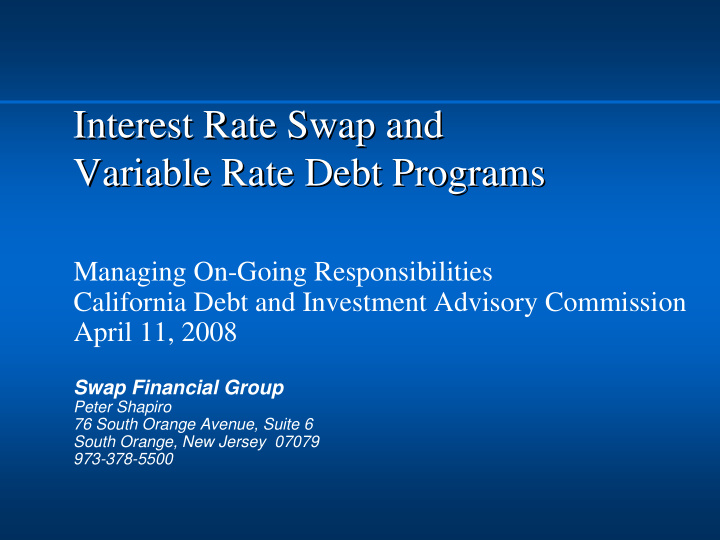



Interest Rate Swap and Interest Rate Swap and Variable Rate Debt Programs Variable Rate Debt Programs Managing On-Going Responsibilities California Debt and Investment Advisory Commission April 11, 2008 Swap Financial Group Peter Shapiro 76 South Orange Avenue, Suite 6 South Orange, New Jersey 07079 973-378-5500
Agenda Agenda � What do you need to know to maintain a variable rate program? � How do actual rates compare to market- wide indexes? � What factors influence actual rates? � How does the market value of a swap change over time? Swap Financial Group 2
Review of swap structure Review of swap structure Fixed Rate Swap Issuer Dealer Floating Index Bond Rate (Floating) Basis Risk comes from the difference between the two Floating Rates Bond Holder Swap Financial Group 3
Swap indexes Swap indexes � The floating side of a swap is usually an index � Two important floating indexes are: – LIBOR (London Interbank Offered Rate): Dominant index for taxable floating rates – SIFMA (Securities Industry and Financial Markets Association Municipal Swap Index, formerly the BMA Index): Dominant index for tax-exempt floating rates � Indexes are never exactly equal to actual rates Swap Financial Group 4
How does LIBOR work? How does LIBOR work? � LIBOR is a rate, set once a day at 11 AM London Time by the British Bankers Association � Every major currency � Every short-term maturity (overnight to one year) � Reflects short-term lending rates between highly creditworthy banks Swap Financial Group 5
How does SIFMA work? How does SIFMA work? � SIFMA is a literal arithmetic average of actual tax-exempt VRDO programs � Mathematically rigorous, determined once a week by MMD Inc. � Reflects multiple remarketing agents, liquidity banks � Only creditworthy programs � 2008 problem: Tainted insurers Swap Financial Group 6
SIFMA vs LIBOR, weekly since 1989 9.00% 8.00% 7.00% 6.00% SIFMA Index 5.00% 4.00% 3.00% 2.00% 1.00% 0.00% 0.00% 2.00% 4.00% 6.00% 8.00% 10.00% 12.00% 1-mo LIBOR
SIFMA vs LIBOR, weekly since 1989 With 'Best Fit' Line, Simple Formula 9.00% 8.00% 7.00% 6.00% SIFMA Index 5.00% SIFMA = 67.7% LIBOR 2 = 0.8967 R 4.00% 3.00% 2.00% 1.00% 0.00% 0.00% 2.00% 4.00% 6.00% 8.00% 10.00% 12.00% 1-mo LIBOR
SIFMA vs LIBOR, weekly since 1989 With 'Best Fit' Line, Compound Formula 9.00% 8.00% 7.00% 6.00% SIFMA Index 5.00% 4.00% SIFMA = 64.5% LIBOR + 18 bps 2 = 0.8993 R 3.00% 2.00% 1.00% 0.00% 0.00% 2.00% 4.00% 6.00% 8.00% 10.00% 12.00% 1-mo LIBOR
SIFMA vs LIBOR, annualized since 1989 7.00% 6.00% 5.00% SIFMA Index 4.00% 3.00% 2.00% 1.00% 0.00% 0.00% 1.00% 2.00% 3.00% 4.00% 5.00% 6.00% 7.00% 8.00% 9.00% 10.00% 1-mo LIBOR
SIFMA vs LIBOR, annualized since 1989 With 'Best Fit' line, Simple Formula 7.00% 6.00% 5.00% SIFMA Index 4.00% SIFMA = 67.5% LIBOR R 2 = 0.968 3.00% 2.00% 1.00% 0.00% 0.00% 1.00% 2.00% 3.00% 4.00% 5.00% 6.00% 7.00% 8.00% 9.00% 10.00% 1-mo LIBOR
SIFMA vs LIBOR, annualized since 1989 With 'Best Fit' line, Simple Formula 7.00% 6.00% 5.00% SIFMA Index 4.00% SIFMA = 63.7 LIBOR + 21 bps 2 = 0.9721 R 3.00% 2.00% 1.00% 0.00% 0.00% 1.00% 2.00% 3.00% 4.00% 5.00% 6.00% 7.00% 8.00% 9.00% 10.00% 1-mo LIBOR
SIFMA-LIBOR relationship is highly seasonal SIFMA as Percentage of LIBOR 120% 100% 80% Last 18 years 60% Low-rate years (2001-2004) 2008 Year-to-Date 40% 20% 0% J J F F M M M A A M M J J J J A A S S S O O N N D D
Why bonds vary from SIFMA Why bonds vary from SIFMA � California – “Specialty State” – Double tax-exemption – Big base of dedicated investors – “The California Premium” � Daily VRDO’s � Auction Rate Securities – Non-puttable, 90% insured – Bond insurer crisis, liquidity crisis – Market seized up this year – Will it ever come back? Swap Financial Group Page 14
0.00% 1.00% 2.00% 3.00% 4.00% 5.00% 6.00% 6/7/1991 6/7/1992 6/7/1993 6/7/1994 6/7/1995 6/7/1996 6/7/1997 BMA vs Cal VRDO's Since 1991 6/7/1998 6/7/1999 6/7/2000 6/7/2001 6/7/2002 6/7/2003 6/7/2004 6/7/2005 6/7/2006 Cal Premium Cal VRDO's BMA
How a swap changes in value How a swap changes in value � Like a fixed-rate bond, a swap changes in value over time � Swap value changes based on three factors: 1. Changes in interest rates 2. Remaining years to maturity 3. Amortization Swap Financial Group 16
Understanding valuation changes Understanding valuation changes � If you are a fixed-rate payer, if rates have risen, the value will be positive to you (and vice versa) � Higher rates mean the swap provider would pay you to get out of the swap (he could find a higher-paying swap in the current market) � GASB rules require you to provide information on the current value of your swaps � New rules will take effect in 2010 that will require more thorough reporting, “effectiveness testing” Swap Financial Group 17
Recommend
More recommend